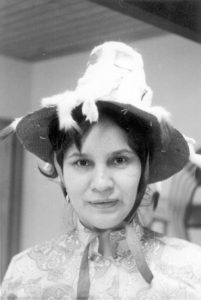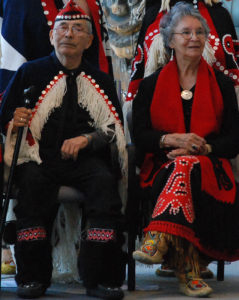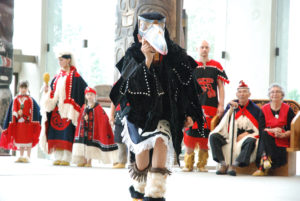Passages: Margaret Harris led a renaissance of Gitxsan songs and dances - Vancouver Ballet Society
- Home
- Features 2020 - 2023
- Passages: Margaret Harris led a renaissance of Gitxsan songs and dances

By Kaija Pepper
When Margaret Hart married Gitxsan Chief Kenneth Harris in 1953, she was groomed by her mother-in-law in the duties and functions that were now her responsibility. Important among them was to carry forward the traditional songs and dances of her husband’s lineage as a chief of the Gitxsan people — the People of the River Mist, who live along the Skeena River in northwestern British Columbia. Over the next several decades, Margaret Harris would become instrumental in revitalizing coastal dances, including co-founding with Kenneth Harris the Dancers of Damelahamid.

The couple were widely recognized for their work as consultants and instructors of Indigenous knowledge and artistic practices. Most recently, in 2019, Elder Margaret Harris and the late Chief Kenneth Harris (1928-2010) were inducted into the Encore! Dance Hall of Fame.
Contemporary choreographer Karen Jamieson was one of many who considered Margaret Harris a mentor and guide. On the Karen Jamieson Dance Facebook page, the Canadian artist recalls creating her cross-cultural work Gawa Gyani in 1991, a creative collaboration with First Nations artists. “Auntie Margaret was trying to teach us a gesture — hands extended out from the body,” Jamieson writes. She describes how they created “stiff shapes that we held in space in an effort to do it right. Auntie Margaret came round and gently whacked our hands, [saying] ‘Soft hands, soft hands, you are giving and receiving, it’s going through you on the rhythms of the earth.’ We came finally to understand the depths and layers within this simple gesture.”
At the end of 2019, Margaret Harris moved into Cedar Village seniors housing in Prince Rupert, where she taught drumming and moccasin- and regalia-making. She died at home on July 15, 2020, at the age of 89.
Born on March 1, 1931, in Churchill, Manitoba, Harris grew up, along with seven siblings, as a Métis member of the Cree Nation. Her father died when she was three. In an interview in the Northern View newspaper, she said about her childhood, “We didn’t have much but we were taught our culture. How to hunt and fish and dry meat and smoke our hides.” There were chores, such as packing wood and water, necessary for survival, but also pleasures, especially Métis jigging, and traditional and modern square dancing. Growing up during the depression in a two-room house had its challenges, but “we had a lot of love,” she said.

At 15, Harris left school to start working, and five years later moved to Prince Rupert for a job at the Miller Bay Hospital for Indigenous people with tuberculosis. She met Ken Harris at a dance and together they became cultural leaders, as well as raising five children of their own and fostering over 50 more.
Their youngest birth child, Margaret Grenier, says all the children in the household were treated the same, adding, “They were all my brothers and sisters, it was just a big family that I grew up in.” Dance was an important part of life within the family unit. “I don’t remember being directly taught dance, it goes back to such early memories of what our family did together. I didn’t know it wasn’t what everyone did.”
Much of Margaret and Ken Harris’ cultural work was about reclaiming lost traditions due to the Government of Canada’s ban on the potlatch, in force from 1884 to 1951, when families and communities were forbidden to practice their songs and dances.
In 1967, at the request of Prince Rupert’s mayor, Margaret Harris founded the Haw Yaw Hawni Naw Salmon Festival, a week-long celebration of First Nations culture that ran until 1986. “There were no carvers, no dancers, nothing,” she recalled in a 2019 video interview for Dance Collection Danse. “I went to the museum and asked if I could borrow some artefacts and they said no, we don’t lend them out.” Her mother-in-law had to use pots and pans in her earlier work reconstructing the family songs, stories and dances, some of which go back thousands of years, but Harris managed to purchase a traditional drum from a collector.
The group of dancers she brought together for the festival were called the Kaien Island Dancers, after the island on which Prince Rupert is built. After the family relocated to Vancouver, they became known as the Dancers of Damelahamid, a name that honours the place where the first ancestors were put on earth from heaven, according to Gitxsan legend.

In 2003, Margaret and Ken Harris handed over the company leadership to Grenier, and took on a less active but very present role as mentors and teachers, joining in performances as singers. That same year, a pole was raised in Margaret Harris’ honour in Metlakatla, Alaska, one of many coastal communities impacted by her cultural work. In the 1960s, Ken Harris lent six Gitxsan songs to the Tsimshian community who had been relocated to Metlakatla by missionaries, and who had lost their own songs and dances. Margaret Harris taught them the dances, and returned many times to support the youth in re-connecting to their culture; the community has its own dance groups now.
Grenier says her mother “had a real ability to accept people,” which drew many to her. The Traditional Mothers Dance Group that Margaret Harris started in Vancouver in 1992 ran until 2015, welcoming Indigenous and other young women with addictions or who were homeless, helping them to learn about their own heritage and culture.
As artistic director of Dancers of Damelahamid, Margaret Grenier follows family tradition by working closely with her husband, Andrew Grenier (the company’s creative producer). Their two children and other extended family members are among the dancers. But the shows are presented with a contemporary multimedia theatricality and high production values.
Margaret Harris was surprised and proud when her daughter and son-in-law made the decision to continue Dancers of Damelahamid and carry the cultural teaching of the Gitxsan to the next generation. She approved the changes that developed in the company over time, appreciating the growing artistry, including the regalia design, which she found “so elaborate and beautiful.”

